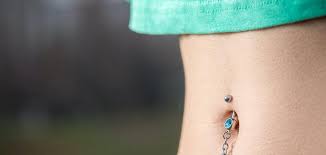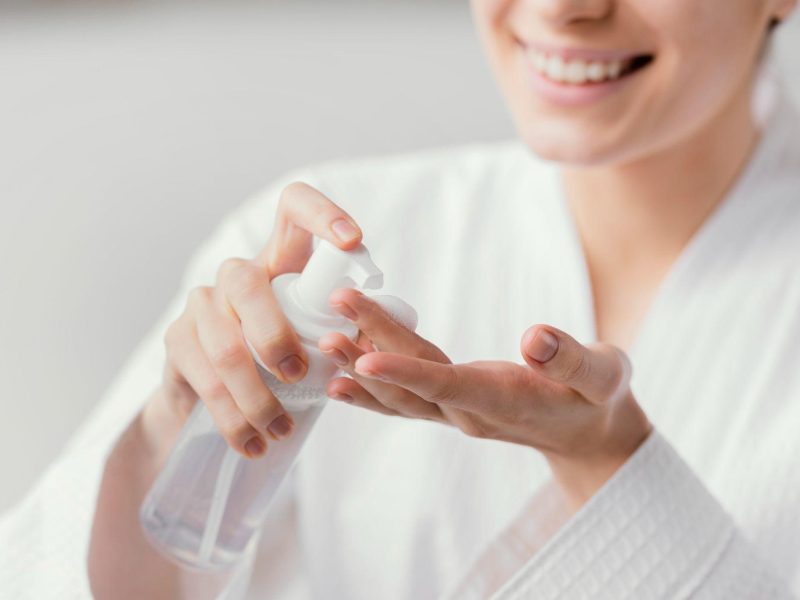Belly button piercing is one of the classics doesn’t mean it’s a super easy or easy-to-pierce piercing. When navel piercing you always have to look closely at the anatomy. In my opinion, you should refrain from piercing if the woman is too thin or if the navel is sticking out/pushes outwards. Don’t miss to read Belly Button Piercing Pain Scale 1-10 before applying for this piercing.
If the lady is too thin, there is simply too much tension/pressure from below on the piercing. In addition, in 90% of cases, the abdominal fold in which the piercing is made is not large enough to withstand the pressure. Which is why the piercing grows out quite quickly or causes problems.
The navel piercing can be pierced 360° around the navel at will. Deviating from the “classic” placement, piercing should be done by experienced people. In the area on the side and below, the danger that it can grow out is increased and special care should be taken here when caring for it.
The piercing is a very beautiful piercing with an overwhelming and varied selection of jewelry.
For the first fitting, I rely completely on PTFE. In my opinion, this is simply the best place to compensate for the daily extreme strain on the stomach/belly button.
Another little fact by the way, if we want to be strict, the navel piercing is one of the so-called surface piercings.
Protection guide for your belly button piercing
Here are the first little tops for care.
What to look out for with the belly button piercing is that high-waisted pants are simply taboo at the beginning. They rub extremely on the piercing and impede the healing quite strongly.
To protect the piercing, it is also advisable to work with a plaster to protect the piercing at the beginning, but please use a sense of proportion here too! An open wound also needs fresh air. But you can find out more about care by clicking the button!
Belly button piercing pain scale 1-10
Belly button piercing pain level is perceived differently from person to person. For some it’s bright, for others that’s it.
On a scale of 1 to 10, if you would give the pain a 4 to 5.
Despite the higher maintenance effort, we are of the opinion that the classic is definitely suitable for beginners. Pain Level of belly button piercing can not be ignored.
However, they should be old enough, i.e not between the ages of 12 and 16, as is unfortunately often the case. Because the growth is far from over there and so a lot can still happen. As a professional, you shouldn’t take responsibility for that.
Belly button piercing Price
With a normal PTFE / BIOFLEX initial stocking with a normal titanium ball, the NAVEL PIERCING costs 60$ with us . But if the normal PTFE / Bioflex jewelry is too boring for you. If you would like a glitter ball or gold / black jewelry, this would usually cost between 5 and 10 € (per ball) extra.
Maintenance of New Belly button piercing
The navel piercing has a similar care routine to others, but given its position, there are some other important factors to consider.
The first thing to consider is to always clean your hands before touching your piercing, to avoid bringing bacteria into it.
Avoid the beaches: Admittedly, this is the place where your navel piercing will shine the most, but if you want your healing phase to take place correctly, you will have to avoid the swimming pool, the sand and any other place that could bring bacteria into your body. piercing. The sand from the beach could bring foreign bodies into your piercing which could cause you infections. You can tan on the edge of the swimming pool, but you will have to wait for complete healing before jumping into the water!
Have a good size jewel: It’s common for the body to reject a new piercing, especially on a navel piercing. Rejection can occur for many reasons, including the use of low-end metal jewelry, but it is often due to the size of your jewelry. Your curved bar will need to be long enough to make room for the slight swelling that will follow after the piercing, but small enough so that it doesn’t pull on your piercing. It will therefore be necessary to wait before opting for a larger navel piercing jewel such as a pendant for example. If you suspect your body is rejecting the piercing, don’t wait to see your piercer.
Use saline solution daily: It is difficult to keep a navel piercing clean due to its position, which is why it will be important to clean it once or twice a day using a saline solution such as the Neilmed spray that we offer on our site with a compress. Avoid alcohol, hexomedine, hydrogen peroxide which burns scar tissue, or betadine which can dry out your piercing.
Be careful with your clothes: Friction on your navel piercing is not to be neglected, if it clings to your clothing, a sudden gesture could come and “tear off” the jewel. Even light rubbing should be monitored, as it may lead to a growth that will complicate your healing and not leave you with the expected look. So avoid clothes that are too close to the body or clothes that could catch on your jewelry, it will also be better to avoid high-waisted jeans as these will continually rub against your new piercing. Some people might advise you to cover your piercing with a compress or a bandage, but it will not be able to breathe and will remain in a warm and humid environment conducive to infection.
Belly button piercing care
After 2 – 3 hours, the possible secondary bleeding usually ends. Means you could carefully remove the band-aid.
Of course, you can also apply another plaster to protect the fresh piercing. This is only necessary if it should still bleed or if you are exposed to heavy dirt / dust.
Please only touch the piercing with clean fingers / hands! Soak/spray on encrustations, wound water, blood etc. with Octenisept. For cleaning, please use a cotton swab soaked in Octenisept or cellulose. Always clean the fresh piercing carefully. Then spray the piercing with Octenisept and let it dry in the fresh air, as we swear by the classic here. Of course Prontolind etc.
In the following 2 weeks, solarium, swimming pools, bathing lakes or your bathtub are UNFORTUNATELY TABOO! Please only take a shower at first and please not excessively
Especially with the belly button piercing, it is important to ensure that you do not do any abdominal training such as sit ups or crunches. Due to the recurring unnecessary movements / squeezing of the tissue, you delay the healing process unnecessarily!
You should also make sure that you do not wear extremely high and tight trousers during the healing process, which can chafe on the freshly pierced piercing.
But just because the belly button piercing is one of the classics doesn’t mean it’s a super easy or easy-to-pierce piercing.
When navel piercing you always have to look closely at the anatomy. In my opinion, you should refrain from piercing if the woman is too thin or if the navel is sticking out/pushes outwards.
If the lady is too thin, there is simply too much tension/pressure from below on the piercing. In addition, in 90% of cases, the abdominal fold in which the piercing is made is not large enough to withstand the pressure. Which is why the piercing grows out quite quickly or causes problems.
The navel piercing can be pierced 360° around the navel at will. Deviating from the “classic” placement, piercing should be done by experienced people. In the area on the side and below, the danger that it can grow out is increased and special care should be taken here when caring for it.
The piercing is a very beautiful piercing with an overwhelming and varied selection of jewelry.
For the first fitting, I rely completely on PTFE. In my opinion, this is simply the best place to compensate for the daily extreme strain on the stomach/belly button.
Another little fact by the way, if we want to be strict, the navel piercing is one of the so-called surface piercings.
Protection guide for your belly button piercing
Here are the first little tops for care.
What to look out for with the belly button piercing is that high-waisted pants are simply taboo at the beginning. They rub extremely on the piercing and impede the healing quite strongly.
To protect the piercing, it is also advisable to work with a plaster to protect the piercing at the beginning, but please use a sense of proportion here too! An open wound also needs fresh air. But you can find out more about care by clicking the button!
Belly button piercing pain scale 1-10
Belly button piercing pain level is perceived differently from person to person. For some it’s bright, for others that’s it.
On a scale of 1 to 10, if you would give the pain a 4 to 5.
Despite the higher maintenance effort, we are of the opinion that the classic is definitely suitable for beginners. Pain Level of belly button piercing can not be ignored.
However, they should be old enough, i.e not between the ages of 12 and 16, as is unfortunately often the case. Because the growth is far from over there and so a lot can still happen. As a professional, you shouldn’t take responsibility for that.

Belly Button Piercing Pain Scale 1-10
Belly button piercing Price
With a normal PTFE / BIOFLEX initial stocking with a normal titanium ball, the NAVEL PIERCING costs 60$ with us . But if the normal PTFE / Bioflex jewelry is too boring for you. If you would like a glitter ball or gold / black jewelry, this would usually cost between 5 and 10 € (per ball) extra.
Maintenance of New Belly button piercing
The navel piercing has a similar care routine to others, but given its position, there are some other important factors to consider.
The first thing to consider is to always clean your hands before touching your piercing, to avoid bringing bacteria into it.
Avoid the beaches: Admittedly, this is the place where your navel piercing will shine the most, but if you want your healing phase to take place correctly, you will have to avoid the swimming pool, the sand and any other place that could bring bacteria into your body. piercing. The sand from the beach could bring foreign bodies into your piercing which could cause you infections. You can tan on the edge of the swimming pool, but you will have to wait for complete healing before jumping into the water!
Have a good size jewel: It’s common for the body to reject a new piercing, especially on a navel piercing. Rejection can occur for many reasons, including the use of low-end metal jewelry, but it is often due to the size of your jewelry. Your curved bar will need to be long enough to make room for the slight swelling that will follow after the piercing, but small enough so that it doesn’t pull on your piercing. It will therefore be necessary to wait before opting for a larger navel piercing jewel such as a pendant for example. If you suspect your body is rejecting the piercing, don’t wait to see your piercer.
Use saline solution daily: It is difficult to keep a navel piercing clean due to its position, which is why it will be important to clean it once or twice a day using a saline solution such as the Neilmed spray that we offer on our site with a compress. Avoid alcohol, hexomedine, hydrogen peroxide which burns scar tissue, or betadine which can dry out your piercing.
Be careful with your clothes: Friction on your navel piercing is not to be neglected, if it clings to your clothing, a sudden gesture could come and “tear off” the jewel. Even light rubbing should be monitored, as it may lead to a growth that will complicate your healing and not leave you with the expected look. So avoid clothes that are too close to the body or clothes that could catch on your jewelry, it will also be better to avoid high-waisted jeans as these will continually rub against your new piercing. Some people might advise you to cover your piercing with a compress or a bandage, but it will not be able to breathe and will remain in a warm and humid environment conducive to infection.
Belly button piercing care
After 2 – 3 hours, the possible secondary bleeding usually ends. Means you could carefully remove the band-aid.
Of course, you can also apply another plaster to protect the fresh piercing. This is only necessary if it should still bleed or if you are exposed to heavy dirt / dust.
Please only touch the piercing with clean fingers / hands! Soak/spray on encrustations, wound water, blood etc. with Octenisept. For cleaning, please use a cotton swab soaked in Octenisept or cellulose. Always clean the fresh piercing carefully. Then spray the piercing with Octenisept and let it dry in the fresh air, as we swear by the classic here. Of course Prontolind etc.
In the following 2 weeks, solarium, swimming pools, bathing lakes or your bathtub are UNFORTUNATELY TABOO! Please only take a shower at first and please not excessively
Especially with the belly button piercing, it is important to ensure that you do not do any abdominal training such as sit ups or crunches. Due to the recurring unnecessary movements / squeezing of the tissue, you delay the healing process unnecessarily!
You should also make sure that you do not wear extremely high and tight trousers during the healing process, which can chafe on the freshly pierced piercing.
Also Read: Tanning Time Chart: Tips for perfectly tanned skin


